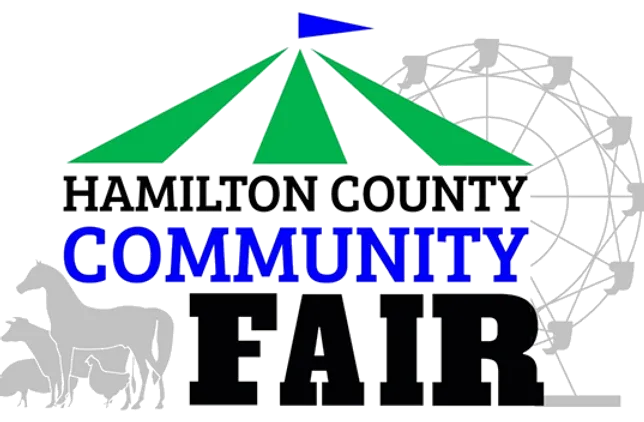
Family Fun at the 2024 Fair
One Price Admission - Includes Unlimited Rides
Hamilton County Community Fair is a family centered fair held at Stricker's Grove Amusement Park in Crosby Township. Stricker's Grove is open to the public all FOUR days and we guarantee there is something for EVERYONE! Whether it's rides , animals, still displays, food, or great entertainment, we have it all! Picnic Meals and Coolers are permitted to be brought into the fair. NO ALCOHOLIC BEVERAGES MAY BE BROUGHT ONTO GROUNDS NO DOGS PERMITTED ON GROUNDS EXCEPT FOR CERTIFIED SERVICE DOGS
Fair Open
04:00pm - 10:00pm
Rides & Concessions Open
05:30pm - 09:30pm
Saturday
Admission $12.00 - Rides Included
Fair Open
12:00pm - 10:00pm
Rides & Concessions Open
01:30pm - 04:30pm
05:30pm - 09:30pm
2024 Daily Fair Schedule
Click on the Underlined Text for more information about an event.
Location Key
Exhibit Hall
EH
Farm Bureau
Show Pavilion
FBSP
Large Shelter
House
LSH
Horse Arena
HA
Wednesday, July 10
Educational Group Day
10:00 Am - 02:00 Pm
RIDES WILL NOT BE OPERATING
Group Preregistration Required
10:00 Am - 02:00 Pm
Animal Displays and 4-H Demonstrations Cincinnati Circus Strolling Acts
OPEN TO PUBLIC
Rides & Concessions
05:30 Pm - 09:30 Pm
Jr. Fair Horse Show
FBSP
09:00 pm
Jr. Fair Sheep Show
FBSP
03:00 pm
Jr. Fair Demonstration Contest
EH
04:00 pm
Jr. Fair Beef Show
FBSP
06:00 pm
Jr. Fair Swin Show
FBSP
07:30 pm
Emerald Creek Trio
LSH
06:30 Pm
Boom Boom Boom
LSH
09:30 Pm
Cincinnati Circus Strolling Acts6:30 pm - 9:30 pm
Thursday, July 11
OPEN TO PUBLIC
Rides & Concessions
05:30 Pm - 09:30 Pm
Jr. Fair Poultry Show
FBSP
09:00 pm
Jr. Fair Horse Groom & Clean
HA
01:00 pm
J.r Fair Goat Show
FBSP
03:00 pm
Jr. Fair Rabbit Show
FBSP
06:00 pm
HA
07:30 pm
Country Step Cloggers
LSH
06:00 pm
LSH
08:00 pm
Cincinnati Circus Strolling Acts6:30 pm - 9:30 pm
Friday, July 12
OPEN TO PUBLIC
Rides & Concessions
05:30 Pm - 09:30 Pm
Jr. Fair Dog Show
FBSP
10:00 pm
Jr. Fair Llama & alpaca Show
FBSP
03:00 pm
J.r Fair Horse Fun Show
HA
04:00 pm
Jr. Fair Livestock Sale Registration
FBSP
5:30 pm - 6:30pm
Jr. Fair Livestock Sale
FBSP
07:00 pm
Generation Gap Band
LSH
07:30 pm
Cincinnati Circus Strolling Acts6:30 pm - 9:30 pm
Saturday, July 13
OPEN TO PUBLIC
Rides & Concessions
01:30 Pm - 04:30 Pm
05:30 Pm - 09:30 Pm
Joe A. Wurzelbacher Showman of Showmen
FBSP
09:00 pm
Jr. Fair Bakeoff
EH
12:30 pm
FBSP
01:30 pm
Cybaele
LSH
01:30 pm
Jr. Fair Dog Agility
FBSP
02:00 pm
Jr. Fair Style Revue
LSH
04:00 pm
Alpaca Fun Show
FBSP
05:00 pm
EH
06:00 pm
Country Step Cloggers
LSH
05:00 pm
LSH
07:30 pm
Family Dance
FBSP
08:00 pm
Cincinnati Circus Strolling Acts6:30 pm - 9:30 pm
Wednesday, Thursday, & Friday
$10.00 per person
$8.00 for senior citizens - 60 and older
2 and under admitted FREE
Saturday
$12.00 per person
$10.00 for senior citizens - 60 and older
2 and under admitted FREE
Cash or Credit** Accepted
$3.00 Processing Fee per Transaction
Livestock Show Community Partners
* Alpaca/Llama Show - Timberlawn Farm LLC
* Beef Show - Adam and Associates
* Dog Show - Paul Sillis Construction
* Goat Show - O'Donnell Construction
* General Projects - Allgeier Auto Parts
* Horse Show - Kehoe Financial Advisors
* Poultry Show - Bruce J. Tumlin Family
* Rabbit Show - Allison & Alex Dicke
* Sheep Show - J Construction Company, Inc.
* Swine Show - Keystone Cooperative
* Showman of Showmen - In Memory of Joe Wurzelbacher
Open Horse Show Partners
* J Construction Company, Inc.
* Wm Lang & Sons Company
* FCN Bank
* Local Union 212, l.B.E.W
* Acme Tree and Landscape Service
* Lighthouse Gunsmith LLC
* Wardway Fuels
* Fraternal Order of Police Local #69
General Community Partners
* Bright Veterinary Clinic
* FCN Bank
* Messer
* Ross County Day
* Miami Savings Bank
* Ernst Signs
* In Memory of Joe Wurzelbacher
Cruise In Community Partner
Thank you to all of our 2024 Supporters!
Premier Fair Sponsors
Click on Business Logos to support them
See Our Livestock Buyers
THANK YOU TO ALL 2023 BUYERS!
Your support is GREATLY Appreciated!
* 2J LLC
* Addie Rosenthal
* Allgeier & Son, Inc.
* Andy Heyob
* Ann's 5 Acres Farm
* Bill & Monetta McCarthy
* Bridgette Berting
* Brown Family Farm
* Car Country
* Carl Alden
* Carl Wurzelbacher
* Carolyn Ostendorf
* Chris Bruggeman
* Cori & Joe Zaenkert
* Dennis Heyob
* Denny & Patty Schultz
* Dicey Outcomes
* Donnie Meece
* Erich Loch
* Fenton Rigging
* Fund a Cause Together, Inc.
* Gary & Theresa Mangold
* HB Jacob
* J Construction
* John & Kathy Burke
* John Tumlin & Son
* Johnson Auctioneers
* JT Jacob
* KD Trucking
* Kielly Wild
* Lou & Lori Schindler
* Lou Schultz
* Maggie & Brian Webb
* Miami Savings Bank
* Mike & Kelly Allgeier
* O'Donnell Construction
* P4 Auto
* Paul Sillis Construction
* Ronda's Dog Grooming
* Ryan Samuels
* Shelly & Nick Gemmell
* Susan Linko
* Timberlawn Farms
* Wm. E Fagaly & Son, Inc.
Fair Association Info
Hamilton County Community Fair Association
The Hamilton County Community Fair Association is a 501(c)(3) non-profit organization made up of dedicated community memberswho volunteer their time to fulfill its purpose.
The purpose of the Hamilton County Community Fair Association is:
* To conduct a community fair and other events that foster youth development.
* To support 4-H club work in Hamilton County, Ohio.
* To render such other services as may be practicable in the improvement of 4-H work.
Hamilton County Community Fair Association Membership
* Membership in the Hamilton County Community Fair Association is open to anyone with an interest in promoting 4-H in Hamilton County which includes 4-H members and their families.
* There is a $15/person non-refundable annual membership fee for anyone who would like to be a member.
* Membership Includes:
- 1 admission pass, good for the entire week of the Hamilton County Community Fair. - Voting privileges for members 13 years of age and older.
* Association membership can be obtained by completing the form inAppendix Aof the Hamilton County Community Fair Rulebook and submitting it with full payment by June 1 of the current year.
* Those who choose not to join the Fair Association by June 1, will be required to pay the daily gate admission of the fair upon entering the gate.
Thank you to all of our 2024 Fair Sponsors
Click on Business Logos to support them
Vendor Basic Information:
The application form needs to be completed and returned by June 26th, 2024
* Booths are 10 x 10
* Only booth tent rentals will have side curtains.
* Items may be left in your booth overnight during the fair.
* If you have a space under the shelter area, it is recommended that you cover your items with a tarp.
* There will be a limited number of spaces and booths available.
* Once your application is received, you will receive detailed information about the times of the fair, set-up, and tear-down, as well as your fair pass.
If you have questions or would like more information please fill out the below form and we will get back to you.
VIDEO



11490 Hamilton-Cleves Road
Hamilton, Ohio 45013
513-993-8068
* Directions from downtown Cincinnati & Northern Kentucky
Take I-75 North to I-74 Indianapolis. Continue on I-74 to Exit 7, Hamilton-Cleves Route 128 Exit. Turn right onto Route 128 and go 7 miles. Go past roller coaster and turn right into Stricker's Grove.
* Directions from I-275, I-75 or I-71 in Cincinnati
Go to I-275. Go West on I-275 and take Colerain Avenue Exit 33-A, Route 27. turn right onto Colerain Avenue (Route 27) and go North. Go approximately 3 miles and take Route 128, Hamilton-Ross Exit. Turn left onto Route 128 and go 2 miles. Stricker's Grove will be on the left.
* Directions from Ronald Reagan Highway (Cross County)
Go West on Ronald Reagan Highway and take Colerain Avenue Exit (Route 27). Turn right off exit and go North. Continue on Colerain Avenue (Route 27) past Northgate Mall. Colerain Avenue will become a divided highway. Take the Route 128, Hamilton-Ross Exit and turn left onto Route 128. Go 2 Miles. Stricker's Grove will be on the left.
* Directions from Kentucky - South of I-275
Take I-275 West through Lawrenceburg, Indiana and take I-74 East to Cincinnati. Take the first exit off I-74, Hamilton-Cleves, Route 128 Exit. Turn left off the exit and go 7 miles. Stricker's Grove will be on the right.
Copyright 2024 | Powered by Chuck Beyers Media | Hcc Fair |

















